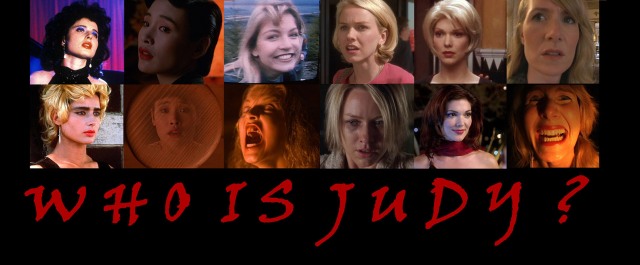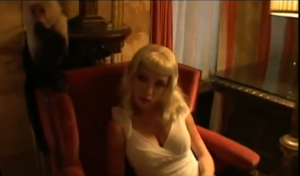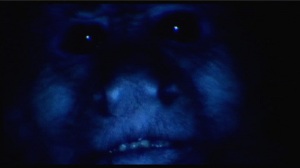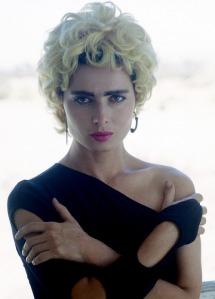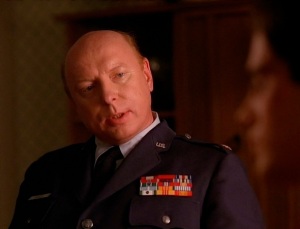
Written by Eden H. Roquelaire for Twin Peaks Freaks.
Disclaimer: This article contains spoilers for Mulholland Drive.
This is the second part in my Mulholland Drive series. In the first part, “Scream Blue Murder,” we examined the mystery of the Blue Box and Key, and analyzed the use of the color blue in the film. In this edition, we are going to take a look at the first Winkie’s Diner sequence, Dan’s dream, and the Man Behind Winkie’s.
“I had a dream about this place.”
“Oh, boy…”
“See what I mean?”
Perhaps one of the most enigmatic scenes from the mysterious Mulholland Drive is the first scene at Winkie’s Diner, wherein a man named Dan tells his companion Herb about a strange dream her had. We are given no explanation as to who Dan and Herb are or how they know each other. Herb never appears in the film again, and Dan only appears once and very briefly in the last half hour of the film, and has no dialogue. So who are these characters, and why are we treated to this scene, before we are even introduced to our heroine, Betty? What do they have to do with the main story?
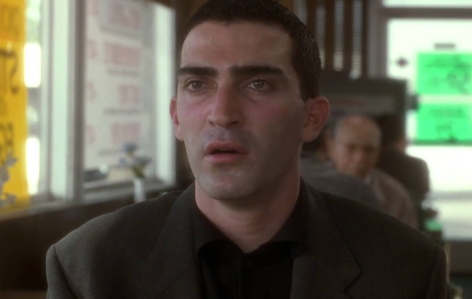
What may at first seem like a tangent may, upon closer inspection, turn out to have more relevance than we realize. First off, it tells us of the importance of dreams, and the idea that dreams and waking life are not so far removed from each other. It immediately makes us question the reality of these events, and whether what we see is really happening or not.
With that said, let’s examine what Dan says about his all-important dream:
Well… it’s the second one I’ve had, but they were both the same… They start out that I’m in here but it’s not day or night. It’s kinda half night, but it looks just like this except for the light, but I’m scared like I can’t tell ya. Of all people you’re standing right over there by that counter. You’re in both dreams and you’re scared. I get even more frightened when I see how afraid you are and then I realize what it is – there’s a man… in back of this place. He’s the one… he’s the one that’s doing it. I can see him through the wall. I can see his face. I hope I never see that face ever outside a dream.
-Dan, Mulholland Drive
Firstly, Dan says that he has had two identical dreams: This is, of course, a reference to classic Lynchian duality, exemplified beautifully in this film. It is also a reference to the actual dream that the movie portrays, and seems to imply that there are two dreams. We will revisit this possibility later. He describes the dream as taking place during “not day or night… kinda half night.” I don’t have a definitive answer for this, but I have a few ideas. Dan seems adamant about the importance of the quality of the light, to the point where he mentions it three times. This could connect to a much later scene, when Adam and Camilla are kissing onset, and Adam yells, “Kill the lights.” Diane stares on in silent rage as the lights fade. Also, the set is depicting a city at night, so, in a sense, it is portraying a false night… not day, or night.
He seems, oddly, to be surprised at Herb’s presence in his dream. “Of all people, you’re standing right over there, by that counter.” We aren’t given any information on Herb’s relationship with Dan, so we can’t do anything more than guess at why his presence would be perceived as surprising to Dan. Near the end of the film, we actually see Dan, not Herb, standing at the counter, while Diane is placing the hit on Camilla. This clues us in on the importance of Dan’s dream in the scheme of the film.
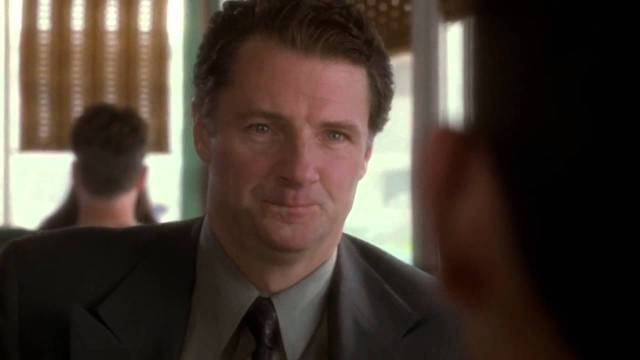
Both Dan and Herb are afraid, for no reason that is explicitly given. Somehow, their fear is connected to the Man Behind Winkie’s. He’s doing something that is causing their fear. But what exactly is he doing, and why does it make Dan and Herb so afraid? Dan somehow perceives the Man Behind Winkie’s through the wall (either of the restaurant, or the wall by the dumpster), and his face disturbs Dan so deeply that he falls short in describing it. He says only, “I hope I never see that face outside of a dream.”
This feeling of dread, this “godawful feeling,” has followed Dan around ever since having these dreams. He is so nervous, he could not eat his breakfast. Herb prompts Dan to come with him to see if the Man is really back there. He gets up and goes to the counter, exactly where he is standing in Dan’s dream. Dan’s anxiety increases when he notices this, but he finally gets up and leads Herb outside the diner, despite his sense of dread.
As the two walk to the back of the diner, notice the two things Dan looks at: The “Entrance” sign, and the pay phone. This is exactly where Betty and Rita go to make the anonymous call to the police about the car crash. Lynch takes the trouble to show us the entrance sign again during the Betty and Rita scene. This further ties Dan’s experience with Betty/Diane. Dan then descends the stairs (you can read this as him descending into the subconscious) and he and Herb make their way towards the dumpster. To his horror, the “Man” from his dream drifts out from behind the dumpster. Dan collapses in shock (according to the script, it says he dies). Herb catches him, calling his name, seemingly unaware of the “Man.” Take note of the ringing that almost blots out Herb’s voice. We’ll get back to that.

Even though we are led to believe that what we just saw takes place in reality, it is in fact, a dream. It takes place just after we see Rita going to sleep, and ends roughly a minute before we see Betty arrive at LAX (there is a short scene in between: The phone call chain, but to me this always seemed to be a precursor to Betty’s arrival). Everything we’ve seen since Diane’s head hits the pillow in the beginning of the film has been a dream. This scene with Dan and Herb is a cipher, put in place to help us decode the rest of the dream that makes up Mulholland Drive.
Let’s go ahead and answer the inevitable question now: Whose dream is it? It’s Diane’s. Despite the fact that the scene is preceded immediately by Rita/Camilla going to sleep, I believe all signs point to this being Diane’s dream. (Besides, according to my theory, Rita is just another projection of Diane, melded with Camilla, but I’ll have to address that in another article.)
Diane is dreaming about two men she noticed sitting behind her once at Winkie’s. From looking at a map of the tables at Winkie’s (put together by Lost on Mulholland Drive), we can guess that in waking life, Diane sat at the table next to these men, perhaps more than once, or perhaps just that one, all-important time, when she put the hit on Camilla. Diane notices Dan standing at the cash register. He happens to be looking back at her. Perhaps she feared he knew what she was up to? Had he possibly overheard from the next booth? She probably associates feelings of guilt with Dan because of this. Remember Dan’s words,
…then I realize what it is – there’s a man… in back of this place. He’s the one… he’s the one that’s doing it.
The one who’s doing what? Something nefarious, apparently. Like, maybe plotting murder? Of course, Diane isn’t a man, but then…. neither is the “man” behind Winkie’s.

The “Man” behind Winkie’s is played by Bonnie Aarons, who, you may notice, is a woman. This strengthens my assertion that the WOMAN behind Winkie’s is a representation of Diane: How she feels, her guilt, her depression, her anger, jealousy, bitterness… all the things that being in Hollywood did to her. Lynch was adamant about being able to see Aarons’ green eyes. Of course, green eyes is a metaphor for jealousy. We see, many, many times in the last half hour of the film, Diane’s face, burning with jealousy. The dirt and grime on her face represents how “dirty” Diane feels, having gone through routine humiliation, until, eventually, she committed one of the ultimate acts of evil: Murder. She feels like she is a monster. She feels ugly inside, guilty for having had a human being she loved murdered. She can’t stand to look at her own face (“I never want to see that face outside of a dream…”)
But when is Diane ever behind Winkie’s? Well, she isn’t… except maybe when she was working as a prostitute.

A common theory is that in order to pay bills while struggling to rise as a star in Hollywood, Diane took a job waiting tables at Winkie’s. We even see one of the Winkie’s coffee mugs on Diane’s table at her apartment. Did she steal that for work? Perhaps so. Perhaps she got caught, and was fired. Either way, Diane seems to have turned to prostitution, at some point. It is believed that the blond woman visited by the hitman is a representation of this period of Diane’s life.
Why is the Man behind Winkie’s described as a man? I admittedly don’t have a definitive theory on this. It’s plausible that Lynch wrote the part before casting a woman, and the name for the character just stuck. An alternative is that the use of the word “Man” as opposed to “Woman” has to do with Diane projecting her failures onto some shadowy conspirators controlling Hollywood, i.e., Mr Roq. So “The Man Behind Winkie’s” is a reference “the Man behind (controlling) Hollywood.” He’s the one who’s doing it; who’s making all these awful things happen to Diane. In her mind, it was all some grand conspiracy to keep her out of the Hollywood Elite.

It’s no secret that David Lynch loves dualism. In every one of his works, you can find some instance of it, and Mulholland Drive is a prime example. Characters, objects and scenes all have doppelgangers, which help us to decipher the meaning behind them. The Winkie’s Diner scene has a doppelganger, but it’s not what you may expect: It’s the scene where Betty and Rita are investigating Diane Selwyn’s apartment. Let’s examine this scene in a new light:
Rita is shaken when she notices two people sitting in a car, apparently staking out the apartment complex. She and Betty duck to avoid detection, as Rita fears these men are looking for her, perhaps to finish the job. She and Betty exit the taxi, and begin to walk around the complex. They spot a suited man waiting outside one of the bungalows, and the two women hide behind a hedge. Betty comments to Rita, “Now you’ve got me scared.” This mirrors Dan’s words to Herb: “I get even more frightened when I see how afraid you are.” This is another connection between Betty/Diane and Dan.
Eventually Betty and Rita find the apartment they’re looking for, only to find out that Diane isn’t living there anymore. The new resident, a woman who looks oddly similar to Rita, grudgingly explains that she switched apartments with Diane. She says that Diane hasn’t been around for a while, and says she’ll come with them to the apartment. However, she is delayed by the ringing of the telephone, and while she is distracted, Diane and Rita go off to find Diane’s apartment. Betty knocks, but there’s no answer, so she breaks in through a window, and lets Rita in through the front door. It’s immediately clear from Betty’s expression that something is wrong: The apartment is permeated by an undeniable stench.
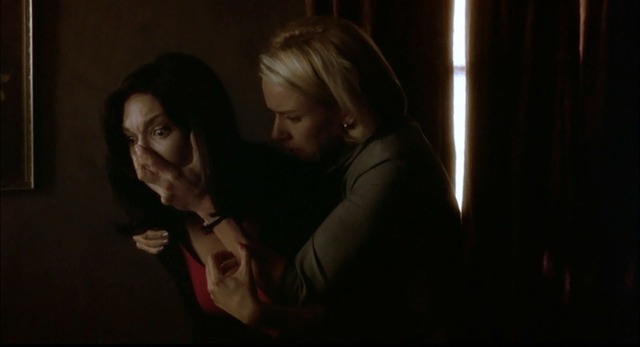
The two women venture cautiously into the apartment. Compare this to the scene of Dan and Herb walking out behind Winkie’s. Like Dan, the women are filled with an obvious dread, and move slowly. Also like Dan, Betty’s eyes move around frequently, examining her surroundings (recall how Dan stared at the entrance sign, the pay phone, and the railing). They both seem to want to look at anything but what is ahead of them. Then, Betty and Rita enter the bed room, and find a corpse lying in the bed.When Rita sees her face, she screams in horror. Her reaction is very similar to Dan’s reaction to seeing the Man Behind Winkie’s. Dan collapses, dead from terror, and Herb catches him, calling his name. When Rita (who represents a dead person) screams, Betty grabs her and covers her mouth. Though not identical, the similarities are clear.
At this point, the neighbor woman has arrived at the front door to the bungalow, and is knocking while Betty smothers Rita’s screams. We don’t hear the neighbor call Diane’s name, but one theory says that this is leaking into Diane’s dream from waking life: As she is sleeping, her neighbor is knocking on her door, calling to her. “Diane,” muffled by her unconscious state, sounds slurred, and becomes “Dan.” This is why, in the Dan and Herb scene, Herb’s voice is almost completely blotted out by a ringing sound.
Both the corpse in the bed and the Man Behind Winkie’s can be construed as representations of Diane’s suicidal thoughts and feelings as she is hitting rock bottom. At this point, to her, there is no life, no chance of happiness. It’s all over. Hollywood killed the person she was, and the person she wanted to be. Now there is only a sad shadow of Diane Selwyn left, and so, to her, her death is as real as if it had already happened. This is the reason for Betty being able to see her own corpse, before she has died.

Analyzing the scene between Dan and Herb provides us with a bounty of keys to help unlock the mysteries of the film. Upon deeper analysis, what at first may have seemed like a tangent that, despite its intriguing elements, had very little to do with the actual movie, now comes across as a pivotal tool to deciphering much of the film. Dan has a certain kind of importance to Diane, as she associates him with her feelings of guilt in the moment she saw him, hence his presence in her dream. Whether or not Herb actually existed is less clear, as is his relationship with Dan, or his purpose in the narrative, other than being someone for Dan to talk to. Some theorize he represents Camilla, and there are a couple of parallels. However, when deciphering Mulholland Drive, it is important to remember that many things were intended to be elaborated upon over the course of the initially planned TV series, and many story-lines were cut when the pilot was turned into a feature film. Had the series progressed, we would have seen more of Wilkins, the Black Book, and perhaps Dan and Herb as well. As it stands, we can only speculate…
That is all for now. Please stay tuned for the next installment of my Mulholland Drive series, and, in the meantime, share your own theories about this scene in the comments. Who or what do you think Herb represents? What is the importance of the reference to the light in Dan’s dream? What does the Man Behind Winkie’s represent?
UPDATE: (3/5/2016)
I have amended my theory on whose dream Mulholland Drive is, based on Dan’s description of his dream.
“It’s the second one I’ve had, but they’re both the same.”
This line holds more importance than we may at first think, as it answers the hotly debated question: Whose dream is it? The answer is, it’s both Diane’s and Camilla’s. Remember in Twin Peaks, when Laura Palmer and Agent Cooper share a dream, but at different times? The same principle is at work here. Mulholland Drive is one dream that happens twice: Once for Camilla, and once for Diane. This would actually strengthen the idea that Mulholland Drive is actually a near-death experience, as both women die, and it is unclear when exactly this dream could have taken place, as various clues and symbols seem to imply that it happens after both women’s deaths.
In the diner scene, Dan says that he has had two dreams, but it is arguable that this scene is not a dream itself, which may shake the veracity of this theory. However, it is my belief that, starting with Fire Walk with Me, virtually every Lynch film has had a key scene placed near the beginning to help decode the rest of the movie. In Fire Walk with Me, the two agents analyze Lil the Dancing Girl. In Lost Highway, the Mystery Man drops some clues to Fred. In Inland Empire, Nikki’s new neighbor tells her a mysterious folk tale. All of these scenes hold obscure importance that connects to many points later on in the film. This is the purpose of the first diner scene in Mulholland Drive, whether it is a dream inside a dream or not. Through Dan, Lynch is telling us important things about the story we are about to experience, and any attempt that deciphering the film should pay the strictest attention to these clues.
Diane and Camilla have the same dream, but at different times, just as Cooper and Laura did in Twin Peaks. Both women’s psyches are influencing each other, although the bulk of the story is influenced by Diane. This, however, explains inconsistencies and otherwise inexplicable elements in the dream half of the film. We see, towards the end of the dream sequence, the two women becoming virtually the same, just like the two dreams.
AGENT COOPER: Laura and I had the same dream.
ANDY: But that’s impossible.
AGENT COOPER: Yes. It is.
